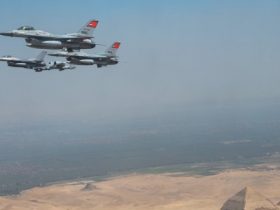Taiwan won approval from main benefactor the U.S. to buy hundreds of loitering munitions, as part of a “porcupine strategy” to use such attritable weapons to help defend the country from a potential Chinese military invasion.
The Defense Security Cooperation Agency’s June 18 approvals included 291 Altius 600M-V loitering munitions from Anduril, plus 720 Switchblade 300s from AeroVironment. The former is valued at $300 million and the latter at $60.2 million.
RELATED
The Altius 600M-V package includes warheads and electro-optic/infrared cameras, pneumatic launchers, transport trailers and ground control stations. The 47lb (12kg) aircraft has a 276-mile (440km) flight range and 4-hour endurance.
As for the Switchblade 300, it comes with both anti-personnel and anti-armor warheads. It is smaller, with a 3.69lb (1.68kg) weight and just a 20-minute endurance.
Chen Kuo-ming, a Taipei-based defense analyst, told Defense News the Switchblades are suitable for anti-personnel use, and the Altius against armor.
The weapons should be delivered in 2024-2025.
“In the face of the Chinese Communist Party’s frequent military operations around Taiwan, the U.S. side in this case agreed to sell arms items that will have reconnaissance and immediate strike capabilities and can respond quickly to enemy threats,” Taiwan’s Ministry of National Defense said in a statement.
The U.S.-Taiwan Business Council also applauded the potential sales. Council President Rupert Hammond-Chambers noted they “add substantially to Taiwan’s inventory of mobile smart munitions, which can be used during on-island fighting all the way through to attacking People’s Liberation Army assets off Taiwan’s coastline”.
Chen said he believes these loitering munitions are good for Taiwan, since they can be used by independent units, even if the country’s navy and air force have been defeated.
However, he expressed concerns about their price – an Altius costs more than five times a Javelin antitank missile, for example. He also questioned the ability of Taiwanese frontline units to see and therefore target enemies beyond visual range.
Chen said the National Chung-Shan Institute of Science and Technology – Taiwan’s defense research and development agency – had displayed various drones, including a loitering munition – at a 2023 Taipei defense exhibition. However, “Until now, we have no real loitering munition for the army to use. So after about nine months, the U.S. government decided to sell these to Taiwan.”
Hammond-Chambers also noted, “Taiwan currently has domestic companies who are working with foreign partners to develop their own indigenous mobile smart munitions. In conjunction with Foreign Military Sales cases such as these, we should expect the Ministry of National Defense to also start procuring locally to meet their defensive requirements.”
At last month’s Shangri-Li Dialogue in Singapore, Adm. Samuel Paparo, head of the U.S, Indo-Pacific Command, outlined a plan to strike back if China attacks Taiwan. “I want to turn the Taiwan Strait into an unmanned hellscape using a number of classified capabilities … so that I can make their lives utterly miserable for a month, which buys me the time for the rest of everything.”
Long-range loitering munitions are one such method.
CAPTIONS
1
The Altius 600 has been delivered to Ukraine, but Taiwan will be the first customer for the warhead-armed Altius 600M-V. (U.S. Army)
2
This image shows the latest Switchblade 300 Block 20 loitering munition from U.S. company AeroVironment. (AeroVironment)
Gordon Arthur is an Asia correspondent for Defense News. After a 20-year stint working in Hong Kong, he now resides in New Zealand. He has attended military exercises and defense exhibitions in about 20 countries around the Asia-Pacific region.
Read the full article here

:quality(70)/cloudfront-us-east-1.images.arcpublishing.com/archetype/T6NCV3PI3ZEFPMZJXI54AZEUUU.jpg)



:quality(70)/cloudfront-us-east-1.images.arcpublishing.com/archetype/S4EGEYTSEJDDLDLJSZONQCZC6Y.jpg)

Leave a Reply